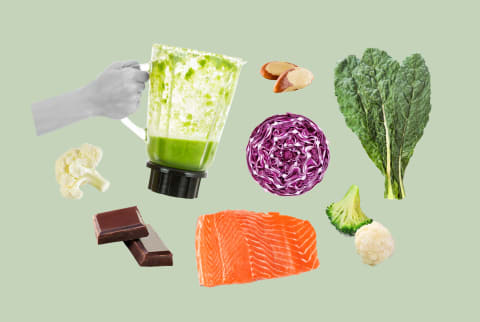Advertisement
What Neurologist David Perlmutter, M.D., Eats In A Day For Optimal Brain Health


As a neurologist, one might think that my dietary preferences and other lifestyle choices would focus on brain health. While that's true, it's really important to understand that, from a holistic perspective, the notion of a "brain-healthy" diet being different from, say, a "heart-healthy" diet really doesn't make sense.
Ultimately, all of the various nuances of diet that are designed to target a specific organ system share two fundamental goals: 1) reducing inflammation, and 2) nurturing our gut microbes. So how do these two ideas play out in terms of what yours truly decides to eat?
I've actually been covering this subject quite a bit lately on Instagram, with the recent launch of my Summer Brain Challenge on Instagram. If you follow along, you'll notice that the first order of business on Day One involved getting more anti-inflammatory foods into your diet. That's because, as it turns out, food choices that target inflammation are typically synonymous with food choices that nurture the microbiome.
Keeping these two goals in mind helps simplify the process of deciding what to eat, and thus, I eat a diet that dramatically limits sugars and refined carbohydrates, celebrates the salubrious qualities of healthful fat, and is rich in fiber. Here, let me walk you through what I might eat on any given day.
"Breakfast"
By definition, "breaking the fast" happens when anything aside from water is consumed. So while I might not eat any real food until noon or later, I do start my day with 1 to 2 cups of coffee. Truthfully, it's one of the first things I think about the moment I wake up. I find that I am super productive in the morning with nothing more than coffee in my stomach. Holding off on eating until noon can also be considered a form of time-restricted eating—one of the many types of intermittent fasting—that may help strengthen neural connections.
Midday meal
By midday, my wife is nice enough to fashion me up a green drink containing some variation of ingredients, such as avocado, cilantro, kale, MCT oil, blueberries, hemp or almond milk, collagen powder, and prebiotic fiber derived from acacia and baobab; or a hot "cereal" containing hemp seed, ground flaxseed, chia, shredded coconut, MCT oil, cinnamon, and some type of nut butter. (As you can see, I'm a fan of MCT oil, a neutral-tasting fat that's been associated with improved memory1 in at least one pilot study.) Another favorite first meal is scrambled eggs in combination with any number of sides like salad, steamed vegetables, mushrooms, goat cheese, or hummus, all drenched in organic, extra-virgin olive oil.
Evening meal
Because our first meal is later than typical, our second meal is typically our last meal of the day. Yes, not having three meals a day sounds iconoclastic, but that is in keeping with my nature.
Our evening meal features mostly vegetables with as wide a variety of colors as possible. We always include a selection that's rich in gut-friendly prebiotic fiber like onions, leeks, or dandelion greens (which are rich in a type of prebiotic fiber called inulin), as well as something cruciferous like kale, broccoli, cauliflower or cabbage. As often as we can, we try to select produce for these sides that is in season, so as to keep our nutritional intake diverse and our ingredients fresh. Importantly, most of my plate is taken up by vegetables while the protein component, which might well be a vegetable like black beans, is more of a side dish.
Speaking of protein, that might also come from wild fish like salmon, cod, or sablefish. Or we might have grass-fed meat or free-range chicken. Fatty fish, like salmon and sardines, are a particularly great choice for brain health, as they contain relatively high levels of the omega-3 DHA, which is powerfully anti-inflammatory and associated with reduced Alzheimer's risk and improved depression symptoms.
We do our best to finish our evening meal early enough as to allow for at least two to three hours of digestion before going to bed, which helps ensure a sound night's sleep—that crucial period of rest when your brain is able to clean house and assimilate and integrate new information.
Snacks
If I feel like munching on something during the day, I'll snack on cashews, almonds, walnuts, pistachios, or some very dark (80% or more) chocolate. All nuts contain a great composition of healthy fats, protein, and fiber, and walnuts, in particular, pack a potent dose of polyphenols and have been associated with2 improved cognitive function. As for chocolate, the darker you go, the higher levels of anti-inflammatory flavanols.
For more nutritional tips from Dr. Perlmutter's Summer Brain Challenge, you can follow along on his Instagram account @davidperlmutter.
Watch Next
Enjoy some of our favorite clips from classes
Enjoy some of our favorite clips from classes
What Is Meditation?
Mindfulness/Spirituality | Light Watkins
Box Breathing
Mindfulness/Spirituality | Gwen Dittmar
What Breathwork Can Address
Mindfulness/Spirituality | Gwen Dittmar
The 8 Limbs of Yoga - What is Asana?
Yoga | Caley Alyssa
Two Standing Postures to Open Up Tight Hips
Yoga | Caley Alyssa
How Plants Can Optimize Athletic Performance
Nutrition | Rich Roll
What to Eat Before a Workout
Nutrition | Rich Roll
How Ayurveda Helps Us Navigate Modern Life
Nutrition | Sahara Rose
Messages About Love & Relationships
Love & Relationships | Esther Perel
Love Languages
Love & Relationships | Esther Perel
What Is Meditation?
Box Breathing
What Breathwork Can Address
The 8 Limbs of Yoga - What is Asana?
Two Standing Postures to Open Up Tight Hips
How Plants Can Optimize Athletic Performance
What to Eat Before a Workout
How Ayurveda Helps Us Navigate Modern Life
Messages About Love & Relationships
Love Languages
Advertisement

These Peanut Butter Cup Protein Bites Make The Perfect On-The-Go Snack
Molly Knudsen, M.S., RDN










